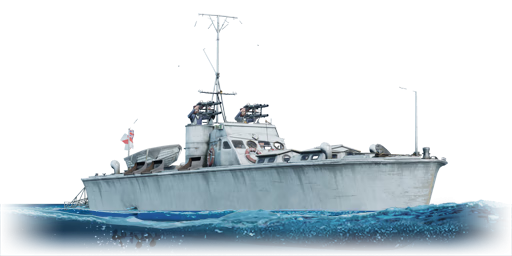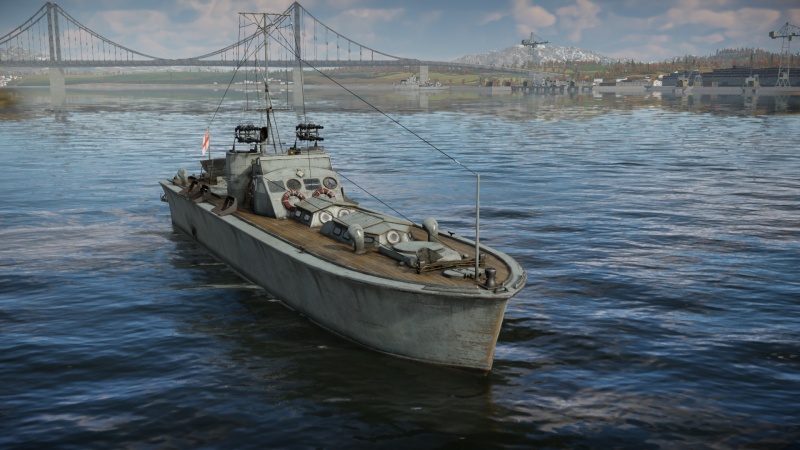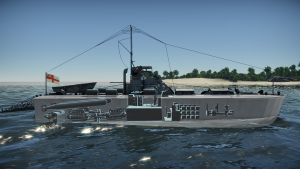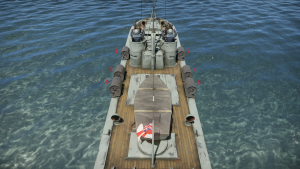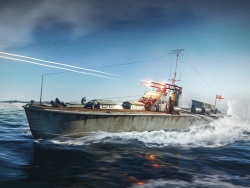Difference between revisions of "MTB-1(2)"
(→Additional armament) |
Inceptor57 (talk | contribs) m (→Usage in battles) |
||
| Line 200: | Line 200: | ||
MTB-1 2 series is, for the most part, identical to her tech tree equivalent, {{Specs-Link|uk_mtb_1series}}. She shares many of the same drawbacks — low per-hit damage, low maximum range, and poor survivability — but with one key difference: whereas the gun turrets are mounted on the fore and aft on MTB-1 2 series, they are mounted side-by-side amidships on MTB-1 2 series. This allows MTB-1 2 series to bring all of her guns to bear without having to expose the rear hull compartments at all, greatly increasing her potential survivability. In general, MTB-1 2 series has the exact same playstyle as MTB-1 2 series but with a bit of extra versatility because of the gun mount placements. | MTB-1 2 series is, for the most part, identical to her tech tree equivalent, {{Specs-Link|uk_mtb_1series}}. She shares many of the same drawbacks — low per-hit damage, low maximum range, and poor survivability — but with one key difference: whereas the gun turrets are mounted on the fore and aft on MTB-1 2 series, they are mounted side-by-side amidships on MTB-1 2 series. This allows MTB-1 2 series to bring all of her guns to bear without having to expose the rear hull compartments at all, greatly increasing her potential survivability. In general, MTB-1 2 series has the exact same playstyle as MTB-1 2 series but with a bit of extra versatility because of the gun mount placements. | ||
| − | + | During battles, avoid long-distance (+2 km) duels with enemy boats because MTB-1 will likely lose against them. Certain long-distance duels are often in maps as the Black seaport and Mediterranean port. Here one of the capture points will be quite far from the main action. If the MTB-1 attempts to capture it, captains should not forget to avoid distant engagements. A common German enemy; the [[LS 3]], outguns and outspeeds the MTB-1. Despite having a lesser crew, this type of enemy can cause a lot of trouble while the MTB's guns will be ineffective. | |
Some roles in which the MTB-1 Series 1 can perform: | Some roles in which the MTB-1 Series 1 can perform: | ||
Revision as of 05:38, 2 March 2021
| This page is about the British motor torpedo boat MTB-1(2). For other versions, see MTB-1 (Family). |
Contents
Description
The MTB-1 2 series is a premium rank I British motor torpedo boat with a battle rating of 1.0 (AB/RB/SB). It was introduced in Update 1.85 "Supersonic". With the split of the naval tech trees in Update "New Power", MTB-1(2) was moved to the coastal fleet tech tree.
The MTB-1 2 series is as a premium variant of MTB-1(1), the reserve vehicle of the British coastal fleet tech tree. Largely similar to MTB-1 1 series, MTB-1 2 series differs in the amount of depth charges that she can carry as well as the placement of the gun mounts, the latter being particularly important as the better firing angles allows MTB-1 2 series to better take advantage of her survivability much more than MTB-1 1 series can.
General info
Survivability and armour
MTB-1 2 series has the following armour layout:
- Hull: 24 mm, wood
- Superstructure: 2 mm, steel
Any gun in the game will easily be able to penetrate the hull and superstructure at any practical range.
The hull is split into three sections. The first section starts at the bow and ends after the ammunition storage; the second ends just behind the bridge; and the third ends at the stern. MTB-1 2 series can be hull-broken by any round with a large enough diameter and explosive mass. In general, this is limited to HE rounds greater with a diameter greater than 4 inches (102 mm). At MTB-1 2 series' battle rating, there is only one gun capable of hull-breaking her:
- the 8cwt QF Mk I, found on Dark Adventurer.
There is one ammunition storage that holds ammunition for both the fore and aft gun turrets. It is located directly behind the forward gun turret just above the waterline. Destroying it will instantly destroy the boat.
MTB-1 2 series has a crew complement of 11. With a stock crew, vehicle is knocked out when 7 crew are lost; with an aced crew, this is increased to 8. Compared to vessels of similar battle rating, MTB-1 2 series' crew complement is average, but compared to everything she can face, the crew complement is below-average. However, the guns are all arranged in such a way that all of them can be brought to bear while facing forwards, which allowed MTB-1 2 series to effectively bow-tank without needing to sacrifice firepower, making her overall survivability average.
Mobility
| Mobility Characteristics | |||||
|---|---|---|---|---|---|
| Game Mode | Upgrade Status | Maximum Speed (km/h) | Turn Time (s) | Turn Radius (m) | |
| Forward | Reverse | ||||
| AB | Stock | 63 | 32 | ~18.64 | ~35.43 |
| Upgraded | 86 | 43 | ~12.67 | ~22.41 | |
| RB/SB | Stock | 53 | 26 | ~20.77 | ~36.73 |
| Upgraded | 61 | 31 | ~17.44 | ~33.15 | |
While her top speed is on the slower side compared to other motor torpedo boats, MTB-1 2 series' manoeuvrability is actually rather good. With a tight turning circle and a decent enough top speed, the mobility is suitable enough for most situations, although the lower top speed really hurts her potential for flanking on certain maps.
MTB-1 2 series has a displacement of 22.4 tons. Because of her small size and relatively low displacement, MTB-1 2 series can be an unstable firing platform in rough waters.
Modifications and economy
Armament
Primary armament
The primary armament consists of eight 7.72 mm Lewis 1916 machine guns in two quadruple mounts, one on the bow and one on the stern. There are 3,880 rounds of ammunition available for each mount, 970 rounds per gun, for a total of 7,760 rounds. Stock, the mounts can traverse horizontally and vertically at a rate of 64°/s; with the "Primary Armament Targeting" modification installed, this is increased to 75°/s. Each gun has a magazine capacity of 97 rounds and a cyclic rate of fire of 551 rounds/min. With a stock crew, the guns can be reloaded in 18.2 seconds; with an aced crew, they can be reloaded in 14 seconds. The 7.72 mm Lewis 1916 machine gun has an absolute maximum range of about 1.7 km against surface targets.
The 7.72 mm Lewis 1916 machine guns, like other low-calibre machine guns, each individually have very poor damage outputs. With their relatively large magazine size and eight of them in total, though, MTB-1 2 series is able to destroy most opponents without needing to reload, assuming that most of the shots land. This, however, comes at the cost of an incredibly long reload, the longest of any reserve vessel and one of the longest of any coastal fleet vessel in general. Because of this, it's best to always fire off any remaining ammunition after engagements to begin reloading in safety and to ensure full magazines at the start of the next engagement.
| Turrets are named sequentially, clockwise, starting at the bow |
| Primary Armament Guidance | |||
|---|---|---|---|
| No.1 Turret (starboard) | No.2 Turret (port) | ||
| Horizontal | Vertical | Horizontal | Vertical |
| ±180° | -5°/+43° | ±180° | -5°/+43° |
Both gun mounts are able to fire in all directions except for a ~47° arc in the direction of the opposite mount. Both gun mounts are able to fully rotate 360°.
There are three ammunition types available:
- Universal: AP · T · AP · T
- 7.7 mm AP belt: AP · AP · AP · T
- 7.7 mm API belt: IT · IT · IT · AP
| Penetration Statistics | ||||||
|---|---|---|---|---|---|---|
| Ammunition | Penetration @ 0° Angle of Attack (mm) | |||||
| 10 m | 100 m | 500 m | 1,000 m | 1,500 m | 2,000 m | |
| Universal | 10 | 9 | 8 | 7 | 6 | 5 |
| 7.7 mm AP belt | 10 | 9 | 8 | 7 | 6 | 5 |
| 7.7 mm API belt | 10 | 9 | 7 | 6 | 5 | 5 |
Within all of the belts, the AP round is the main damage dealer. The T round deals very little damage to both surface targets and aircraft, only really being useful as a guide for aiming. As a result, the AP belt, with its 3:1 ratio of AP:T rounds, is the most effective in all situations. The Universal belt, with its 1:1 ratio of AP:T rounds, is a direct downgrade from the AP belt in terms of damage and should not be used as the AP belt is unlocked from the start. While the API belt, comprising wholly of IT rounds, may initially seem like the best option due to the incendiary effect of the IT rounds, the IT round in practice is actually comparable to the T round in damage, rarely starting fires and doing incredibly little damage against surface targets. Against aircraft, the difference in damage between the AP belt and the API belt is negligible.
Additional armament
MTB-1(2) has four possible loadouts:
- 2 x Mk.XII torpedo
- 6 x Mk.VII depth charge
- 2 x Mk.XII torpedo, 6 x Mk.VII depth charge
- Without load
Torpedoes
MTB-1 2 series can carry two 18 inch Mark XII torpedoes. These are carried internally in the aft of the boat and are launched through the transom tail first, i.e. facing forwards.
| Torpedo Characteristics | ||||||||
|---|---|---|---|---|---|---|---|---|
| Torpedo Mode | Mass (kg) | Maximum speed in water (km/h) | Travel distance (km) | Depth stroke (m) | Arming distance (m) | Explosive type | Explosive mass (kg) | TNT equivalent (kg) |
| No | 1559 | 83 | 5.50 | 1 | 50 | TNT | 224 | 224 |
| Yes | 1559 | 107 | 3.67 | 1 | 50 | TNT | 224 | 224 |
The 18-inch Mk.XII is fairly average in terms of maximum speed and range, though it has a rather small explosive mass compared to other torpedoes. Still, a hit with the Mk.XII torpedo is more than enough to destroy any boat. Besides that, this torpedo is unnoteworthy.
The Torpedo Mode modification is available as a rank IV modification. Installing it will give the following changes:
| Torpedo Mode Specification Changes | |
|---|---|
| Max Distance (m) | Max Speed (m/s) |
| -1829 | +7 |
Since it's unlocked from the start, it's best to always keep Torpedo Mode installed. The maximum speed of a torpedo is more valuable in coastal battles than its maximum range. Coastal fleet maps are also small enough that the decreased range with Torpedo Mode installed isn't much of an issue. Note, though, that the Torpedo Mode modification on MTB-1 2 series has the opposite effect compared to most other vessels. Typically, the maximum range is increased at the cost of speed.
In RB, always set the depth stroke to the minimum 1 m setting. This is because many vessels that MTB-1 2 series can face will not have a deep enough draught to fuse the torpedo at a depth stroke setting of 4 m. In AB, depth stroke is automatically set to the most optimal setting.
When using torpedoes, be aware that unless they are already launched, the torpedoes be shot at and destroyed. Upon being destroyed, there is relatively high chance for them to detonate, instantly destroying the boat. To avoid this, fire the torpedoes early on in battle — as well as after any subsequent reloads in AB — or simply don't take them at all. Torpedoes are a situational weapon, so it's largely down to personal preference whether or not to take them.
Depth Charges
The Mk.VII depth charges are carried around the bridge area, three on each side. They are dropped one at a time in the following order:
- Port, foremost
- Starboard, foremost
- Port, centre
- Starboard, centre
- Port, aftmost
- Starboard, aftmost
Before spawning, the detonation time delay can be set anywhere between 3 seconds and 10 seconds.
| Depth Charge Characteristics | |||
|---|---|---|---|
| Mass (kg) | Explosive Type | Explosive Mass (kg) | TNT Equivalent (kg) |
| 196 | TNT | 130 | 130 |
There is almost no practical reason to use depth charges on any naval vessel in the game. Although they usually result in a one-hit kill if used properly, they are extremely situational, requiring the player to close to point-blank ranges to even use them. In almost every case, anytime a depth charge could be used, the guns or torpedoes can be used instead to greater effect. In fact, depth charges tend to actually be a liability in battle, since they essentially act as exposed ammo racks before they're dropped. Like torpedoes, they can be shot at, and if destroyed, they have a chance to detonate, instantly destroying the boat.
Despite this, some success can be had in dropping them very close to a slower opponent. When doing this, remember the depth charge drop order, since most likely, only the depth charges dropped on the side closed to the enemy will deal any damage. Additionally set the depth charge time delay to the minimum 3 seconds, since any higher time delay will only allow the depth charge to sink further away from the target, giving them more time to move out of the way. Again, using depth charges is extremely situational, and they will only be a liability the vast majority of the time, so take them at your own discretion.
Usage in battles
MTB-1 2 series is, for the most part, identical to her tech tree equivalent, MTB-1(1). She shares many of the same drawbacks — low per-hit damage, low maximum range, and poor survivability — but with one key difference: whereas the gun turrets are mounted on the fore and aft on MTB-1 2 series, they are mounted side-by-side amidships on MTB-1 2 series. This allows MTB-1 2 series to bring all of her guns to bear without having to expose the rear hull compartments at all, greatly increasing her potential survivability. In general, MTB-1 2 series has the exact same playstyle as MTB-1 2 series but with a bit of extra versatility because of the gun mount placements.
During battles, avoid long-distance (+2 km) duels with enemy boats because MTB-1 will likely lose against them. Certain long-distance duels are often in maps as the Black seaport and Mediterranean port. Here one of the capture points will be quite far from the main action. If the MTB-1 attempts to capture it, captains should not forget to avoid distant engagements. A common German enemy; the LS 3, outguns and outspeeds the MTB-1. Despite having a lesser crew, this type of enemy can cause a lot of trouble while the MTB's guns will be ineffective.
Some roles in which the MTB-1 Series 1 can perform:
Sea brawler
This is one of the MTB-1's strengths. With good manoeuvrability, the MTB-1 can surprise enemy boats and open fire really close to them. Using the good turning abilities to try and dodge the enemy's main guns while firing too; working with every cover to become a harder target to hit. Employ the MTB-1's mobility to sneak close and personal, using secondary armaments such as the torpedoes and depth charges to multiply the damage; is here when depth charges and torpedoes take an important role. Big targets such as the R-boots and the VAS 201 are vulnerable to them. Be aware, they can carry depth charges and mines so sometimes is better to use the torpedoes and keep the distance. Perform lighting attacks then retreating with a smoke cover back to allies.
There is also always available the possibility to request a battleship's main calibre artillery. This one is very important if sailors see groups of enemies seizing a point or going through a tight coastal passage. Often this artillery will swing apart the fragile and light boats. Pretty remarkably sighting indeed!
Close-range aircraft interception
The MTB-1 2 series can be used to intercept enemy planes, flying boats, and bombers flying low towards allied shipping. Considering these planes sometimes will be slow, the work is pretty much doable for the MTB-1 (The guns provide immediate sustained fire, enough to track and fix the leading). If about to be attacked by an enemy plane, the MTB-1 can disengage, turn in the opposite direction and use a smoke cover to defend. This tactic is also valuable if is needed to protect an allied ship. Thanks to the decent turret range and mobility, the MTB-1 could always keep the enemy plane at gunpoint.
An important thing to remember is to avoid firing planes out of range. This often could lead to several planes attacking overwhelmingly since the location of the MTB-1 got exposed by its own tracers. It could be wiser to wait for a closer enemy approach before opening fire.
With these tactics, captains could additionally appeal for the speed and the small silhouette, attempting to avoid combat not only staying behind the allied side of the map but often going after the allied boats and ships; providing fire support and also repairing any bigger squadmate in need. Any sort of indirect fire without taking damage is the goal. Help maintain capture points or help attack points then fall back when necessary.
- On arcade, the torpedoes are particularly useful in close maps such as Andaman sea or African gulf. There MTB-1 can constantly reload torpedoes and keep launching them in numerous directions. Such as capture zones and the enemy's spawn zones; something should eventually get to them. Don't forget the availability of torpedo mode.
- Don't forget to destroy the whole enemy's compartments (coloured black once destroyed). Proceed to fire on other areas of the boat, once a compartment has been destroyed. This means the ammo of the MTB-1 will be used efficiently while exposing the boat to the minimum amount of damage.
- If the MTB fires at a single section of the enemy boat, is unlikely it will be destroyed. Scatter the fire tactically.
- Always angle the hull to show as little of the sides and rear and possible.
- Stick to close-range engagements so that the guns' low maximum range isn't an issue.
Pros and cons
Pros:
- Relatively large magazine capacity: can destroy most opponents without needing to reload
- Placement of guns allows all guns to fire directly ahead
- Large volume of fire can quickly take down low-flying aircraft
- Third best crew count among reserve boats
- Due to large spaced compartments, it can survive relatively well
- Now is possible to target all guns to stern and bow; unlike the MTB-1 1 series
- Premium bonus allows good rewards
- 6 depth charges, 2+ compared to the MTB-1 1 series
Cons:
- Only armed with small-calibre guns: low damage output per gun and low maximum range
- Longest reload of any reserve boat
- Relatively weak torpedoes (low explosive mass compared to other similar torpedoes)
- Guns are severely outranged by most of the other Rank I boats (+1.5 km)
- The ability to fire with all guns to both port and starboard is reduced; compared to the MTB-1 1 series
- Big target compared to other smaller reserve boats; it receives a lot of fire
History
Though the Royal Navy had operated a small number of coastal boats during the first World War, by the 1930s, these flotillas had long been dissolved and the Royal Navy had yet to construct any more. The first two coastal boats since WWI were ordered on 27th September 1935 by the Royal Navy, the order being given to British Power Boat Company based at Hythe, a town near Southampton. In addition to this initial order, four more were ordered on 19th October 1935. These six boats were completed by November 1936, and, with their commissioning on 27th April 1937, the Royal Navy Coastal Forces was founded. Following this, three more boats were ordered on 7th December 1936 and nine more on 11th January 1938. In total, 18 boats were ordered, all of them being completed by 1939.
These boats had a standard displacement of 18 tons and had a length of 60 ft. 4 in., a width of 13 ft. 4 in., and a drought of 2 ft. 10 in. at standard displacement. They were powered by three Napier Sea Lion petrol engines, each driving a single shaft, and could reach speeds of around 30-35 knots. Each boat could carry two 18 inch torpedoes which were stored internally on rails above the engines. On the stern were two more rails that could be folded down to the transom, extending the torpedoes' rails outside of the boat. The torpedoes fired facing forwards down the rails, after which the boat that fired them would have to turn to evade their path. In addition to torpedoes, the boats were also armed with a number of depth charges and, depending on the exact boat, up to eight Lewis guns.
MTB 1, the first of the boats, was redesignated MTB 7 in 1937. Similarly, MTB 7 was redesignated MTB 1 in the same year. In 1938, the former MTB 1, now MTB 7, was redesignated MTB 13. At the same time, MTB 13 was redesignated MTB 7. Finally, later in 1938, the former MTB 1, now MTB 13, was again redesignated MTB 19. Thus, by the start of WWII, the boats were numbered MTBs 1-12 and 14-19 and formed two MTB flotillas: 1st MTB Flotilla, consisting of MTBs 1-6 and 14-19; and 2nd MTB Flotilla, consisting of MTBs 7-12.
The 1st MTB Flotilla was sent to the Mediterranean at the start of WWII and was based at HMS Vulcan in Malta. They were soon recalled back to England in December 1939 to be based at HMS Beehive, Felixstowe, though MTB 19 was sent to HMS Vernon, Portsmouth. Along the way back, due to bad weather, MTB 6 had to be foundered. After they arrived, the remaining boats continued to operate in the English Channel until they were either lost or replaced. Those lost were MTBs 15, 16, and 17, all of which were mined in 1940.
The 2nd MTB Flotilla was commissioned in 1938 and assigned to HMS Tamar, Hong Kong. They were all lost during the Battle of Hong Kong in December 1941. MTB 8 was bombed by IJN aircraft and was damaged beyond repair, and MTB 12 was sunk in action by IJN landing craft. The remainder of the 2nd MTB Flotilla was scuttled on 26th December 1941.
Media
- Images
See also
External links
- unithistories.com - Royal Navy Coastal Forces 1940-1945
- naval-history.net - British vessels lost at sea in World War 2 - MGB, MTB, SGB, ML, etc - originally published in British Vessels Lost at Sea, 1935-45, His Majesty's Stationary Office, 1947
- mwadui.com - Royal Navy Coastal Forces - Hong Kong
- Coastal Forces Heritage Trust - History
- yalumba.co.uk - British Power Boat Co Page 1 and British Power Boat Co Page 5
- Wikipedia - Coastal Forces of the Royal Navy
| Britain boats | |
|---|---|
| Motor torpedo boats | Brave Borderer · Dark Aggressor · Dark Aggressor TD · Fairmile D (617) · Fairmile D (697) · Fairmile D (5001) · HMS Gay Archer |
| MTB-1(1) · MTB-1(2) · MTB Vosper · MTB Vosper(2) · MTB-422 | |
| Motor gun boats | Dark Adventurer · Fairmile A (ML100) · Fairmile B (ML345) · Fairmile C (312) · Fairmile C (332) · Fairmile D (601) · Fairmile H LCS(L)(2) |
| HMAS Arrow · HMAS Fremantle · MGB-61 · MGB-75 · ML 1383 · SGB Grey Fox · SGB Grey Goose | |
| Gunboats | HMS Spey |
| Britain premium ships | |
|---|---|
| Motor torpedo boats | MTB-1(2) · MTB-422 · Fairmile D (5001) · HMS Gay Archer |
| Motor gun boats | MGB-75 · SGB Grey Goose |
| Gunboats | HMS Spey |
| Sub-chasers | LÉ Orla |
| Frigates | HMS Whitby |
| Destroyers | HMS Montgomery · HMS Valhalla · HMS Verdun · ORP Garland · HMS Jervis · HMCS Haida · HMS Mohawk · HMS Cadiz · HMS Diamond |
| Light cruisers | HMS Belfast |
| Battleships | HMS Iron Duke |


